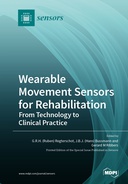Explore

Wearable Movement Sensors for Rehabilitation: From Technology to Clinical Practice
0 Ungluers have
Faved this Work
Login to Fave
This Special Issue shows a range of potential opportunities for the application of wearable movement sensors in motor rehabilitation. However, the papers surely do not cover the whole field of physical behavior monitoring in motor rehabilitation. Most studies in this Special Issue focused on the technical validation of wearable sensors and the development of algorithms. Clinical validation studies, studies applying wearable sensors for the monitoring of physical behavior in daily life conditions, and papers about the implementation of wearable sensors in motor rehabilitation are under-represented in this Special Issue. Studies investigating the usability and feasibility of wearable movement sensors in clinical populations were lacking. We encourage researchers to investigate the usability, acceptance, feasibility, reliability, and clinical validity of wearable sensors in clinical populations to facilitate the application of wearable movement sensors in motor rehabilitation.
This book is included in DOAB.
Why read this book? Have your say.
You must be logged in to comment.
Rights Information
Are you the author or publisher of this work? If so, you can claim it as yours by registering as an Unglue.it rights holder.Downloads
This work has been downloaded 119 times via unglue.it ebook links.
- 119 - pdf (CC BY) at Unglue.it.
Keywords
- 3-D motion analysis
- accelerometer
- accelerometers
- accelerometry
- arm use
- assistive device
- assistive devices
- body-worn sensors
- center of pressure
- Cerebral palsy
- circadian motor behavior
- clinical
- clinical setting
- constrained extended Kalman filter
- constraint
- distance measurement
- Embedded sensors
- Exercise
- falls
- fourier transform
- functional linear model
- Gait
- gait analysis
- gait planning
- Gait rehabilitation
- GMFCS level
- goniometer
- Hemiplegia
- human–machine interaction
- implementation
- IMU
- Inertial measurement unit
- inertial measurement units
- inertial motion units
- insole pressure sensors
- kinematics
- Lie group
- Locomotion
- Low back pain
- lower limb amputation
- Machine learning
- magnetometer-free
- Measurement
- Motion Capture
- motion tracking
- motor function
- n/a
- neurological disorders
- older adults
- outcomes
- pathological gait
- perinatal stroke
- physical activity
- Physical Therapy
- physically active workers
- pose estimation
- range of motion
- real-time gait detection
- Rehabilitation
- relative orientation estimation
- sensor
- Shoulder
- single leg squat
- spinal cord injury
- stride length
- Stroke
- Technology, engineering, agriculture
- Technology: general issues
- tetraplegia
- upper extremity
- upper limb performance
- validity
- Walking
- walking distance
- wearable devices
- wearable sensor
- Wearable sensors
- wearable technology
- wireless sensors network
Links
DOI: 10.3390/books978-3-0365-2064-3Editions

